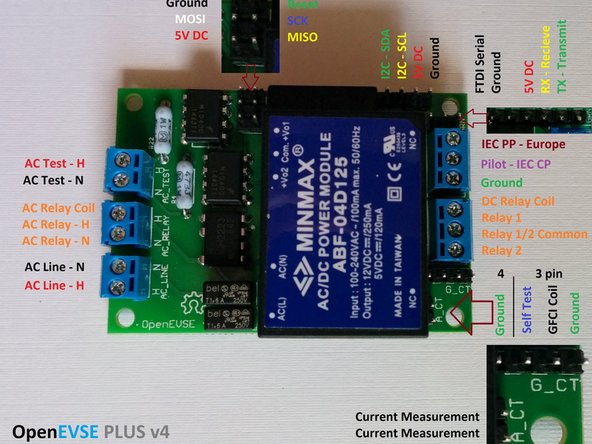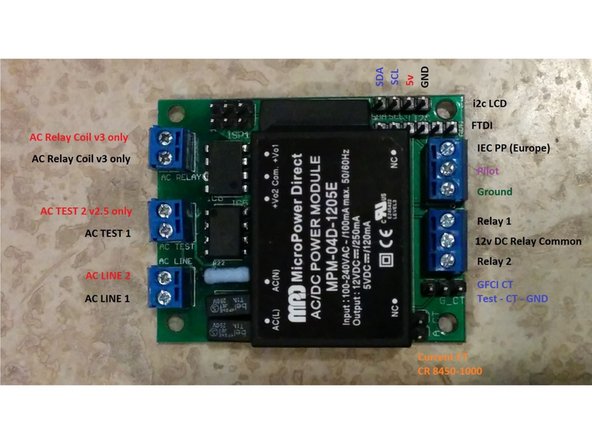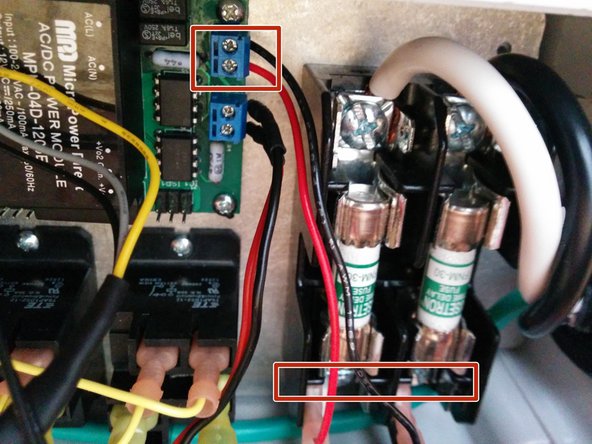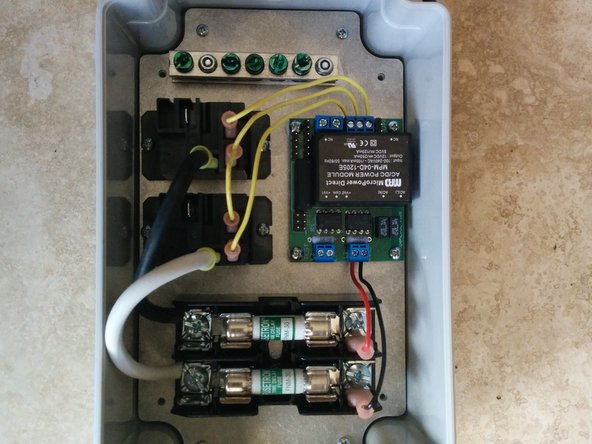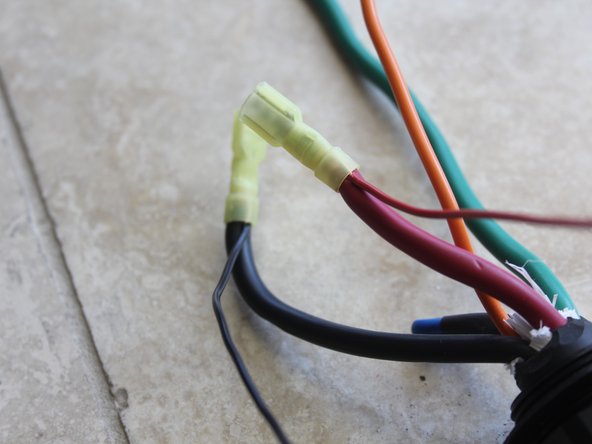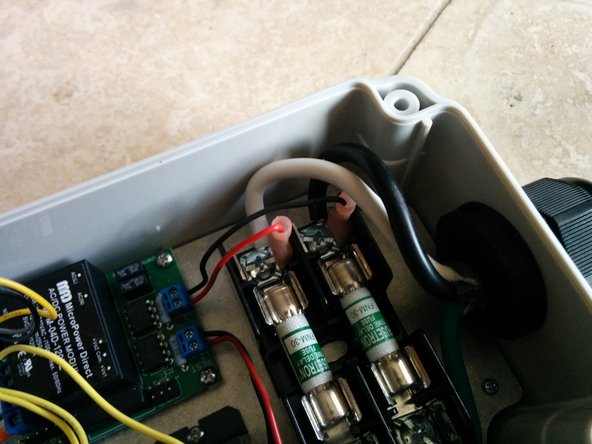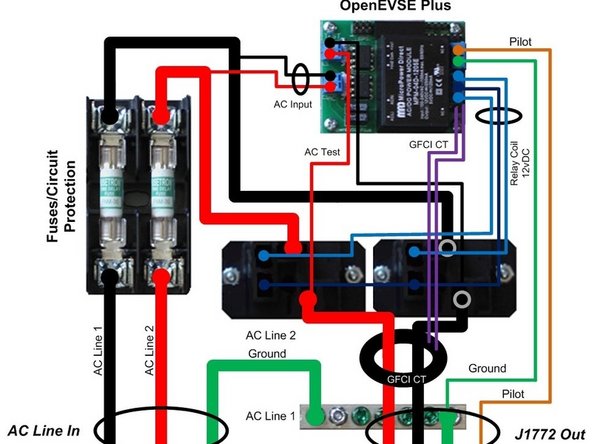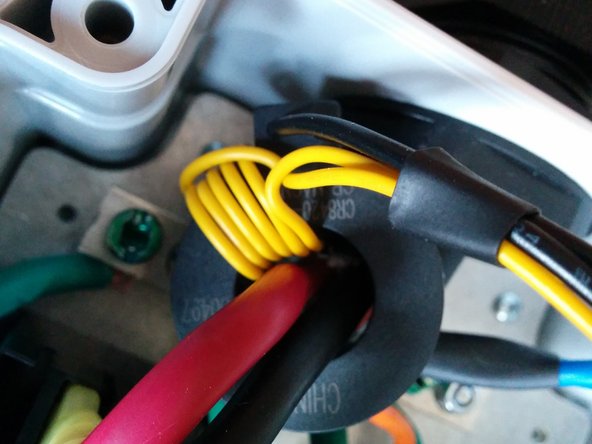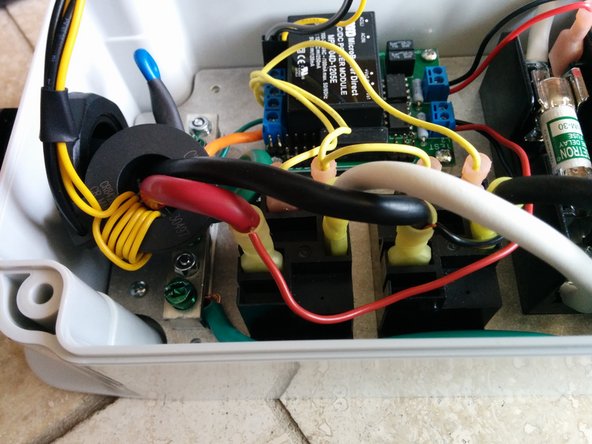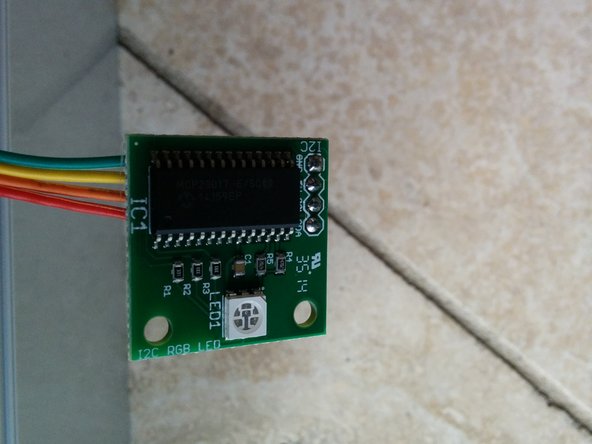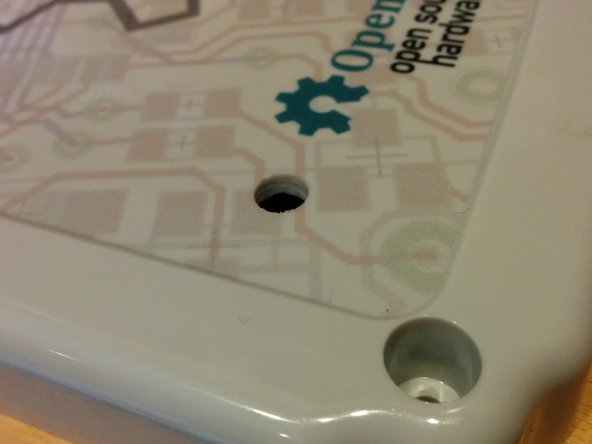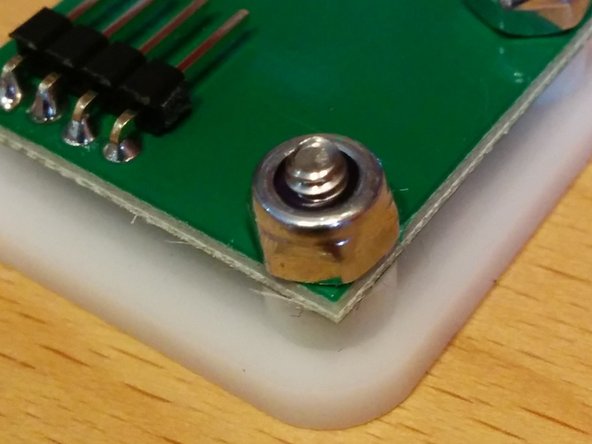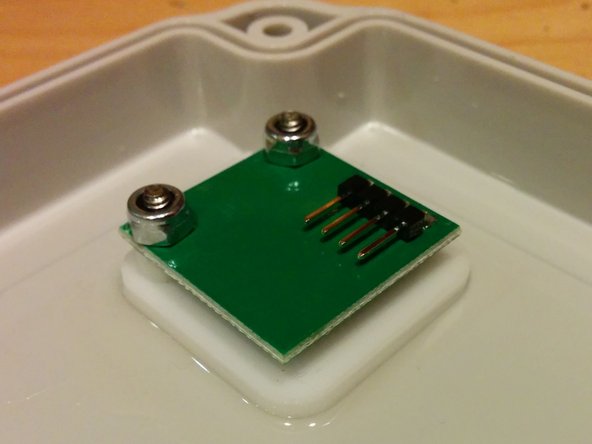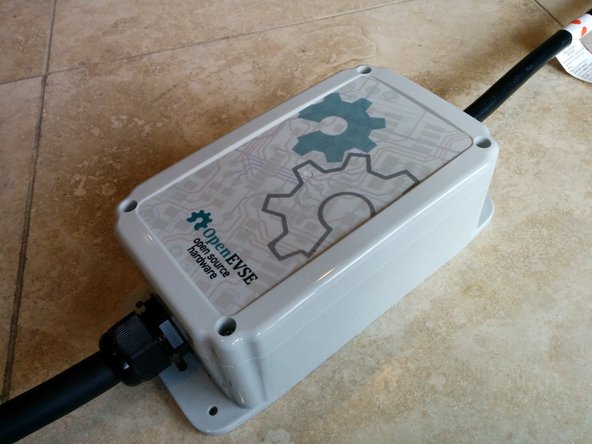Introduction
- Warning Assembly of a Electric Vehicle charging station requires wiring Alternating Current (AC) components that will be exposed to voltages from 100 to 250v. If you do not have the experience and knowledge required to safely work with AC voltages please consult with an experienced electrician for assistance and inspection of your work.
- Note Regularly inspect your charging station. Pay special attention to excess heat, components, handles, and wiring will be warm but they should not be HOT...
- Always Disconnect your charging station from power before performing an inspection and/or maintenance
-
-
Mount fuse block with 2 - 3/8" screws from the top and lock nuts on the bottom.
-
Position relays so the small tabs are to the inside for easier routing of low voltage wires.
-
Mount Relays with 2 - 3/8" screws from the top and lock nuts on the bottom.
-
-
-
Mount OpenEVSE Plus board with 5/8" screws from the top. NOTE: Kit now includes the latest v4 board which is slightly longer. Drill 2 holes to accommodate upgraded board.
-
Place nylon spacers between OpenEVSE board and mounting plate. Tighten Lock Nuts from the bottom. Do not over tighten.
-
Mount Ground block with 2 - 3/4" screws from the bottom. Tighten Lock nuts from the top.
-
Connect OpenEVSE Ground to the ground Block with a small piece of green wire. Ensure connections are secure.
-
Crimp Yellow connector to 10AWG wire. Screw to the Fuse block. Wire can come from excess from AC cord or J1772 cable.
-
Ensure crimps are secure. Do not solder connectors designed for crimping. Do not connect and disconnect terminal. If loose, discolored, or damaged replace immediately.
-
-
-
Review the connection diagram for the board you received in your kit.
-
v4 After July 2015
-
v2 Before July 2015
-
-
-
Connections are slightly different between board versions. Refer to these diagrams if the image in this guide does not match your board version.
-
-
-
Crimp 22AWG wire to larger 1/4" pink QC connectors. Connect to Fuse block QC terminals.
-
Screw the 22AWG wires to the AC line block on the OpenEVSE board.
-
When connecting relay coil tabs. Ensure the QC terminal slides down the tab. It is possible to wedge the QC connector in by bending tab to the side.
-
Connect OpenEVSE common relay output (center pin) to 1 relay coil terminal on each relay using small pink QC connectors.
-
Connect OpenEVSE controller Relay 1 output to remaining pin on first Relay.
-
Connect OpenEVSE controller screw terminal Relay output 2 to remaining pin on second relay.
-
-
-
Prepare J1772 cable
-
Prepare J1772 cable. Strip Cable back at least 8". Put Cable Gland on cable, it may take some effort depending on the diameter of the cable.
-
Ground and Pilot conductors should be 7" - 8" long.
-
One Hot conductors should be about 5" long and the other slightly shorter. Crimp Yellow QC connectors to the Hot Conductors AND a 22AWG wire for the AC_Test connections.
-
Ensure crimps are secure. Do not solder connectors designed for crimping. Do not connect and disconnect terminal. If loose, discolored, or damaged replace immediately.
-
-
-
Prepare AC cable (if Applicable). Strip back outer insulation 7". Put Cable Gland on cable.
-
Ground conductor should be 6" - 7" long.
-
Hot conductors should be 5" long.
-
Secure AC Cord Cable Gland to enclosure on the side with the fuse block.
-
Connect Hot Wires to the fuse block.
-
-
-
Connect J1772 cable gland to the enclosure base.
-
Run both HOT lines through the GFCI coil. Connect GFCI cable to the G_CT header. Black wire closest to the board edge.
-
Connect J1772 Hot lines to relay outputs.
-
Connect the AC_Test leads to the OpenEVSE board AC_Test header.
-
Connect J1772 Ground to Ground block
-
Connect J1772 Pilot wire to the OpenEVSE board pilot terminal. See diagram in Step 3.
-
-
-
Connect 4 pin LED cable to the OpenEVSE board.
-
Pin closest to board edge is ground on the OpenEVSE Board. See diagram in Step 3.
-
LED may be used temporarily for testing and troubleshooting or mounted to the lid.
-
Pin closest to board edge is groung on LED Module.
Another problem with the unit is received is that one of the holes on the body of the plastic enclosure is not tapped and I can not tighten the screw more than 2 turns. As a result, one of the corners is not water tight.
The enclosure holes are not tapped, they have metal fittings that are pressed from the bottom. The fitting are visable from the bottom. You can check that the fitting is pressed properly and please ensure that the screw was not cross threaded.
1) The picture shown in Step 7 shows the AC input lines connected directly to the power inlet side of the fuse block but the schematic diagram shows the AC input connected to protected side of the fuse block.
2) The schematic shows a relay coil but there wasn't one included in the kit.
3) The instructions in Step 8 say to connect the J1772 pilot wire to the Circuit board but there are no detailed instructions on how to do so. The pilot lead from the J1772 cable did not fit the connector on the circuit board. I trimmed a few of the stands on the pilot cable to make it fit. I don't know if that is the best technique.
4) There a number of errors, omissions and inconsistencies in these directions. it would be helpful of the author and the manufacturer provided new accurate instructions with updated pictures, more detailed information as to the AC power connections and Dual AC options and shipped a mounting plate with the proper holes.
Overall I am very dissatisfied with this kit.
1) OpenEVSE board is fused with 1A fuses on both lines, it may be connected before or after the main fuses.
2) Each relay has a 12vDC coil built in.
3) Not sure how to make it more detailed, will check the wording.
4) I will provide a full refund and a prepaid shipping label to return your kit.
Don't forget to run the thin green wire from the pilot ground to the ground terminal, I did not see it in the assembly steps but it shows on the diagram and this one photo.
Off Grid Hawaii - Resolved on Release Reply
Deleted Step 1. Instruction to connect ground is now:
Step 2 bullet 4 with the red Caution Symbol.
-
-
-
Drill a hole (up to 1/4") in the bottom left of the enclosure leaving at lease 1/2" inch from the edge of the graphics.
-
Mount the LED logic board to the laser cut plate with the LED facing down so the LED will shine through the plate.
-
Screws should be recessed into the plate.
-
Place the spacer between the plate and LED and the nylon lock nut on top.
-
Bond the Assembly with watertight, high temperature adhesive such as Epoxy (Best) or Shoegoo E6000 to the enclosure lid so the LED lines up with the hole and the hole is completely covered by the plate.
-
Ensure good coverage of the adhesive on the plate to create a watertight seal.
I can’t find the LED status codes. Could someone please post them somewhere.
I can charge at 110v just fine but on 220v I get a red light. Not been an issue before.
Thanks.
Sheldon Fourie - Resolved on Release Reply
-
-
-
If LED was not mounted to the lid in the previous optional step, Remove LED after testing is complete.
-
Close enclosure evenly applying pressure to all 4 screws.
-
Cancel: I did not complete this guide.
3 other people completed this guide.
9 Comments
1) The circuit board provided did not line up with the holes on the mounting plate. I had to drill two new holes. I aligned the circuit board to the two holes closest to the terminal block and marked two new holes closet to the fuse block.
2) The item description says this EVSE will work with 120V or 240V. I am assuming it is auto sensing and we will need to build an adapter cable to accommodate either 120V or 240V.
3) the write up and instructions have us mounting the LED close to the Gear symbol on the Open EVSE logo but there is a mark round detent in the exact middle of the cover. it looks like this might be a better place. there seems to be plenty of clearnace betwwen the cover and the components beneath it. is this a good place to mount the LED?
Here are a bunch of adapters for a NEMA L6-30 Input cord from EVSEupgrade.
1) The Basic kit now includes the improved v4 board at no extra cost over the older v2. It allows the addition of a current measurement coil and WiFi and it has improved ground testing. The board is slightly longer so two holes need to be drilled.
2)Yes the board will auto detect the input and set 12A for 120 and 24 for 240. EVSE upgrade makes several adaptors NEMA L6-30 to many other common outlets.
3) The LED can be mounted wherever you like as long as the cable can reach.
The circuit board you linked on Feb 14 shows, in order from bottom to top, on the lower left, two-wire inputs for (1) ac line, (2) ac test, and (3) ac relay. On the version I was sent, the test and relay inputs are reversed, so, from bottom to top, my board has (1) ac line, (2) ac relay, and (3) ac test. Can you please confirm that the ac test leads from the J1772 should go into the ac test inputs on the circuit board (top connector), and that there is nothing connected to the ac relay connector? Thanks.
You are correct the v4 uses a slightly different layout. For the 30A kit with DC relays the AC_Relay connections are not used.
I am assuming the difference between
"AC Line 1" and "AC Line 2"
"AC Input 1" and "AC Input 2"
"AC Test 1" and "AC Test 2"
can be either 120V or 240V with a maximum of 30 amps?
Cole Purbaugh - Resolved on Release Reply
The circuit board pictured has a two wire terminal for pilot and ground wires. The one supplied in my kit has a three wire terminal. Can I get an update on where the pilot and ground wires go with the three wire terminal?ts4evse
Terry Akins - Resolved on Release Reply







